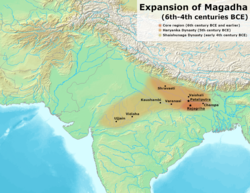Shishunaga king
| Shishunaga Empire | ||||||||||
|
||||||||||
|
Extent of the Shishunaga Empire
|
||||||||||
| Capital | Rajgir, Vaishali, later Pataliputra,Patna | |||||||||
| Languages |
Sanskrit Magadhi Prakrit Other Prakrits |
|||||||||
| Religion |
Hinduism (Brahmanism) Buddhism Jainism |
|||||||||
| Government | Monarchy | |||||||||
| King | ||||||||||
| • | 413–395 BCE | Shishunaga | ||||||||
| • | 367–345 BCE | Mahanandin | ||||||||
| History | ||||||||||
| • | Established | 413 BCE | ||||||||
| • | Disestablished | 345 BCE | ||||||||
|
||||||||||
The Shishunaga dynasty is believed to have been the third ruling dynasty of Magadha, an empire of ancient India. According to the Puranas, this dynasty was the second ruling dynasty of Magadha, succeeding the legendary dynasty founded by Brihadratha.
Shishunaga, the founder of the dynasty, was initially an amatya or "minister" of the last Haryanka dynasty ruler Nāgadāsaka and ascended to the throne after a popular rebellion in c. 413 BCE. The capital of this dynasty initially was Rajgir; but later shifted to Pataliputra, near the present day Patna, during the reign of Kakavarna. According to tradition, Kakavarna was succeeded by his ten sons. This dynasty was succeeded by the Nanda Empire in c. 345 BCE.
Puranas depict Shishunaga kings as Kshatriyas.
Shishunaga founded his Shishunaga or Shaishunaga empire in 413 BCE with its capital in Rajgir and later Pataliputra (both in what is now Bihar). Buddhist sources indicate that he had a secondary capital at Vaishali, formerly the capital of Vajji, until it was conquered by Magadha. The Shishunaga dynasty ruled one of the largest empires in the Indian subcontinent.
According to the Puranas, Shishunaga was succeeded by his son Kakavarna and according to the Sinhala chronicles by his son Kalashoka. On the basis of the evidence of the Ashokavadana, Hermann Jacobi, Wilhelm Geiger and Ramakrishna Gopal Bhandarkar concluded that both are the same. During Shishunaga's reign, he was the governor of Varanasi. The two most significant events of his reign are the Second Buddhist council at Vaishali in 383 BC and the final transfer of the capital to Pataliputra. According to the Harshacharita, he was killed by a dagger thrust into his throat in the vicinity of his capital. According to Buddhist tradition, he had nine or ten sons, who were ousted by Ugrasena Nanda.
...
Wikipedia

